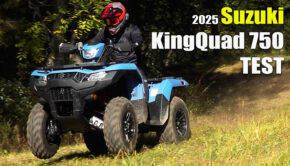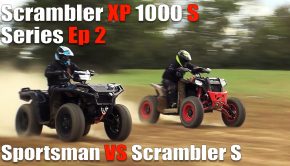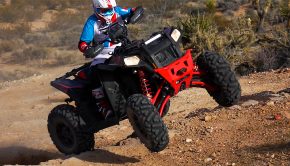Published on May 14th, 2019 | by Joe
Suzuki KingQuad 750 vs KingQuad 500 Shootout
What difference does $1,000 Make?
So, you’re interested in a new Suzuki KingQuad 500 or 750. Both machines have a proven track record of being durable, backed up by a number of viewer comments through the years. So, which KingQuad interests you most? Is it the 500 with its power steering equipped models saving you a cool $1,000? Or, is it the 750? It’s the largest displacement, single-cylinder, 4×4 ATV on the market, for only $1,000 more than the 500. Of course, financed over 5 years, that extra $1,000 may wind up costing you a bit more depending on your credit. Perhaps the 500 being light in its class means you don’t really need that extra 229cc anyway. Also, both the KingQuad 500 and 750 share virtually identical chassis, suspension, brakes, bodywork, etc., so what’s the only difference anyway, a little power? Perhaps picking between these two machines isn’t quite as easy as we initially thought. Fortunately, we happen to have both the KingQuad 500 and 750 on hand, so thought we’d see just how they compare.
2019 Updates
For 2019, Suzuki beefed up the frames, mildly improving suspension and handling with updated shocks, and added a revised sway bar. A two-inch hitch receiver boosted towing capacity by 333 lbs. Suzuki brought back the handlebar mounted headlight pod with an updated instrument display, on-board storage was increased by 4 liters, plus more small updates were shared across both models. Both machines received new fuel mapping to meet EPA standards. New fuel mapping and clutching resulted in a small improvement in overall engine performance in the 750, which also benefits from a new oil jet in the crankcase to lubricate the underside of the Pictor for improved cooling, lubrication, and durability. You can watch our tests of both the 2019 KingQuad 500 and 750 for complete details and detailed reviews of both machines.
What’s different?
Essentially, the engines are about the only thing separating these two ATVs. The 500’s engine displaces 493cc with a bore and stroke of 87.5 x 82 mm. It features a four-valve, single-overhead cam design. The 750 displaces 722cc with a bore and stroke of 104 x 85mm. It features a more complex four-valve, double-overhead-cam head design. Both engines have a 9.9:1 compression ratio, well within the margin of safety for long lasting engines.
Both Quads have CVT transmissions with high and low ranges, plus neutral and reverse. Each features unique clutch calibration to keep its top end in the best part of the power curve for the machine’s intended use.
We can’t remember ever hearing a viewer saying they wish an ATV with a remotely lockable front differential had one of those self-locking front differentials like Can-Am or a drive system that switches back and forth from two to all-wheel-drive like Polaris. Discriminating ATV enthusiasts typically prefer a standard two-wheel drive, four-wheel drive setup with a lockable front differential, the type of drive system featured on both the KingQuad 750 and 500.
According to the California Air Research Bureau, the 500 produces 38.2hp. The 750 produces just under 50hp. Both machines are said to respond well to adding a high-quality aftermarket exhaust and fuel controller like HMF’s Titan Series exhaust and Fuel Optimizer, adding between 10-15% horsepower across the RPM range.
Shared Features
Sharing a beefed up chassis and suspension with new gas-charged shocks feature 5-way preload adjustment. The dual A-Arm front ends feature 6.7” of travel with the dual arm rear suspension featuring 7.7” of travel. Braking is handled by standard hydraulic disc brakes front and a low-maintenance, sealed, multi disc system rear.
Towing capacity is identical at 1,323 lbs, as is the capacity of their steel racks at 66 lbs front and 132 lbs rear. Both machines also feature 10.8 liters of on-board storage.
Bodywork, lighting, and most other parts of these two machines are identical.
The Competition
For our little friendly rivalry, we had Pat Collins, in his brand new Fly Racing F-16 gear, ride both machines back to back on the same sections of trail. We let the KingQuads take turns towing each other around, and finished with a short timed moto for both machines.
Starting both machines, the 500 consistently seemed to spark to life a little more quickly. We’re not sure if this is due to a quicker cranking speed on the 500 or if the 750’s fuel injection is running a bit leaner. The 500 seems to emit a bit less vibration at idle or on the gas. The CVT’s clutching keeps the 500 running a bit higher in the RPMs, taking advantage of a bit more engine speed to get the job done. The 750 seems to run lower in the RPM’s where you can feel the pulses of the engine a bit more through the handlebars. It’s not annoying, but the 750 simply emits a bit more vibration than the 500.
Comparing engine performance, there is no denying that the 750 puts out more torque and horsepower. This is most noticeable when you make an abrupt demand on the engine exiting a turn or when you’re attacking a steep climb with little run. With our trailer loaded down with the 500, the 750 was working less, running at a lower RPM to accomplish the same task, although the 500 wasn’t struggling to pull our trailered 750 either.
For times when we weren’t trying to push the engine’s limits, the 500 didn’t seem very lacking compared to the 750. Both machines accelerated smoothly and predictably from a dead stop and their transmissions seemed to do equally well at keeping power available on demand. Cruising the trail, we could ride either machine happily without complaint or any great bias. The slightly more vibration prone 750 seems a bit quieter due to the fact that it operates at a lower RPM seemingly all of the time. While you might expect the larger 750 to burn that much more fuel, its lower RPM operation should make it more competitive with the 500 when it comes to fuel mileage. We admittedly didn’t do a direct fuel mileage comparison, but based on our experience, we would expect fuel usage to be pretty close.
Suzuki made a step forward for 2019, improving the handling and suspension characteristics of both machines.The front shocks are now notably a bit firmer than the rear shocks. While the ride is still pretty balanced feeling, the front shocks don’t use as much travel under high or low-speed compression scenarios. They don’t bottom as easily on jump landings. The front end compresses less on g-outs and under braking. The higher riding front end makes steering and handling a little more predictable any time the front end is under load with no serious complaints of oversteer from our test riders on the 2019 models. Previous years’ handling predictability greatly benefitted from power steering, and even with the shock and sway bar updates, we suspect that power steering is still an important feature for potential KingQuad owners.
Excessive roll from the lightweight, uninspiring Carlisle tires holds both machines back in the turns. If handling performance at more than a casual pace matters to you, both machines would benefit greatly from a tire swap.
Steering accuracy, handling, and suspension performance are virtually identical: although, on smaller, uneven bumps and ripples in the trail, we found the 750 slightly better at absorb bumps and keeping the tires tracking with the terrain under throttle. With the 750 weighing in at 725 lbs, a mere 11 lbs more than the 500, the extra thrust of the 750’s engine drives harder into oncoming bumps, forcing the suspension to become a bit more active, similar to the way a machine with a heavier sprung mass often traverses small bumps better than a lighter machine. Cruising along, suspension is pretty much identical. Charging hard, the 750 gets the edge.
The extra power of the 750 doesn’t really push the brakes much harder on the trail. Again, curb weights are within 11 lbs with identical towing capacities. Braking performance is essentially equal on both machines.
Wrapping up our test, we sent Pat on a quick run out to the end of his property and back on each machine. He climbed over a jump section on his motocross track, ripped through a high-speed section, crossed the bridge at the end of the property, and then raced back on a somewhat twisty trail. The 750 went first with a time of 1:30:25. The 500 was respectably close at 1:33:50. While the machine’s power plants aren’t radically different cruising the trail, when you want to get up and go, the 750 is a bit quicker. If Pat had run his larger hills as part of the loop, the gap would have been bigger.
Conclusion
On paper, the 500 appears just as capable as the 750 when it comes to getting work done. On almost any trail, in stock trim, it will get you from point A to point B just like the 750, unless you’re trying to prove who’s faster. For a hunting machine, casual trail rider, rental fleet, Construction Company, or large farmer with tractors or other larger machinery to work with, the slightly more economical 500 makes a lot of sense.
If you want a machine to casually cruise the trails with an occasional spirited rip and you don’t ever see yourself spending money on performance upgrades, the 500 is a good unit.
For the small farmer who’s more reliant on their ATV to pull a heavy trailer, drag things, or pull implements that might otherwise be pulled by a small tractor, the 750’s extra power will mean less stress on the engine over time. If you are looking for a 4×4 ATV as much or more for play as for work or you plan on adding larger tires, you will most likely be happier in the long run with the 750. The price of an exhaust and fuel controller for the 500 would eat up a lot of the difference in price between the two machines. Additionally, the 750’s clutch setup leaves more performance lurking in the 750 compared to the 500 with a simple clutch upgrade.
While very similar machines, we feel the KingQuad 500 and 750 are definitely better suited to two different types of rider. Riding both machines back to back helped us decide which machine would be a better fit for us and, hopefully, it will help you make a more educated buying decision as well.
If you have any other questions regarding either of these machines, please leave us a comment and check out our individual Test videos of the 500 and 750 for more in-depth reviews.
For more info on the Suzuki KingQuad 500 and 750, or their full line of ATVs and motorcycles, visit www.suzuki.com .









